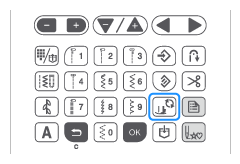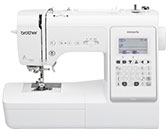Innov-is A150
FAQs & Troubleshooting |
How do I thread the machine (Threading the upper thread)?
- When threading the upper thread, carefully follow the instructions. If the upper threading is not correct, the thread may become tangled or the needle may bend or break.
- Never use a thread weight of 20 or lower.
- Use the needle and the thread in the correct combination. For details on the correct combination of needles and threads, refer to “Combination of fabric, thread and needle”.
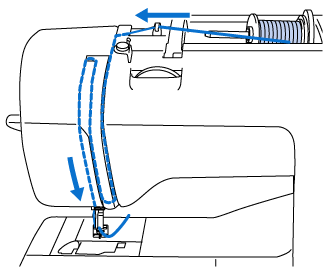
When threading the upper thread, carefully follow the instructions.
[1] Preparing for threading
-
Turn on the machine.
-
Press
 (Needle position button) once or twice to raise the needle.
(Needle position button) once or twice to raise the needle.
>> The needle is correctly raised when the mark on the handwheel is at the top, as shown below. Check the handwheel and, if this mark is not at this position, press (Needle position button) until it is.
(Needle position button) until it is.
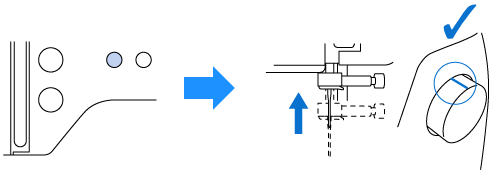
-
Lower the presser foot lever.
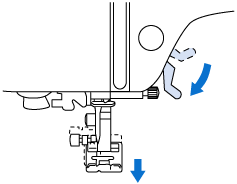
-
Press
 .
.
>> The screen changes, and all keys and operation buttons are locked (except ).
).
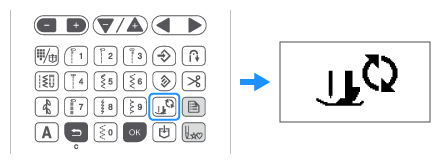
If
 is pressed while the presser foot is raised, an error message appears. Lower the presser foot lever and press
is pressed while the presser foot is raised, an error message appears. Lower the presser foot lever and press  again.When threading the needle, be sure to press
again.When threading the needle, be sure to press on the operation panel to lock all keys and buttons, otherwise injuries may occur if the “Start/Stop” button or any other button is pressed and the machine starts.
on the operation panel to lock all keys and buttons, otherwise injuries may occur if the “Start/Stop” button or any other button is pressed and the machine starts.
-
Raise the presser foot lever to raise the presser foot.

If the presser foot is not raised, the machine cannot be threaded.
[2] Threading the upper thread
-
Remove the spool cap and place the spool of thread onto the spool pin.
Slide the spool onto the spool pin so that the thread unwinds to the front from the bottom. Otherwise the thread may become tangled around the spool pin.
(1) The thread unwinds to the front from the bottom.
-
Slide the spool cap onto the spool pin.
Slide the spool cap as far as possible to the right, as shown, with the rounded side on the left.

-
Choose a spool cap that best fits the size of spool being used.

- If the spool or the spool cap is not positioned correctly, the thread may become tangled around the spool pin or the needle may break.
-
When using the spool as shown below, use the small spool cap, and leave a small space between the cap and the spool.
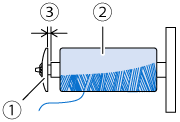
(1) Spool cap (small)
(2) Spool (cross-wound thread)
(3) Space
-
When using thread that winds off quickly, such as transparent nylon thread or metallic thread, place the spool net over the spool before placing the spool of thread onto the spool pin. If the spool net is too long, fold it to fit the size of the spool.
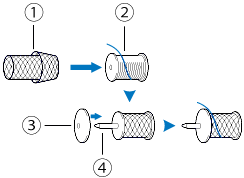
(1) Spool net (2) Spool
(3) Spool cap
(4) Spool pin
-
Choose a spool cap that best fits the size of spool being used.
-
Pass the thread under the thread guide, then under the thread guide cover and to the front.
Hold the thread with your right hand so that there is no slack in the thread that is pulled out, and then pass the thread under the thread guide cover with your left hand.
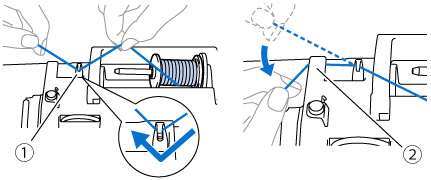
(1) Thread guide
(2) Thread guide cover
-
Pass the thread through the thread channel in the order shown below.
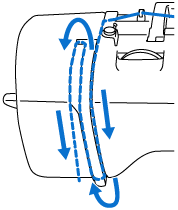
-
Make sure that the thread is passed into the thread take-up lever as shown below.
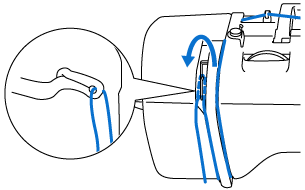
-
Slide the thread behind the needle bar thread guide.
The thread can easily be slid behind the needle bar thread guide by holding the thread in your left hand, then feeding the thread with your right hand, as shown. Make sure that the thread is passed through to the left of the tab of the needle bar thread guide.
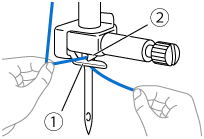
(1) Needle bar thread guide
(2) Tab
[3] Threading the needle
-
Check that the needle and thread are compatible with the needle threader. If they are compatible, continue with the next step.
- The needle threader can be used with machine needles 75/11 through 100/16.
- The needle threader cannot be used with the wing needle or the twin needle.
- When thread such as transparent nylon monofilament or specialty threads are used, it is not recommended to use the needle threader.
-
If the needle threader cannot be used, insert the thread through the eye of the needle from front to back by hand. Refer to “Threading the needle manually (without using the needle threader)”.
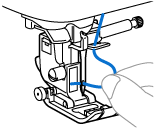
-
Pull the end of the thread, which has been passed through the needle bar thread guide, to the left, then pass the thread through the notch of the threader thread guide, and then firmly pull the thread from the front and insert it into the slit of the threader thread guide disk marked “7” all the way.

(1) Notch of the threader thread guide
(2) Threader thread guide disk
-
Cut the thread with the thread cutter on the left side of the machine.
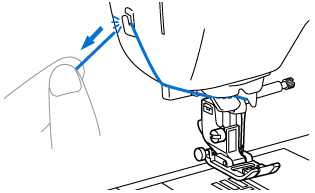
- If the thread is pulled through and cannot be cut correctly, lower the presser foot lever so that the thread is held in place before cutting the thread. If this operation is performed, proceed to step 4.
-
When using thread that quickly winds off the spool, such as metallic thread, it may be difficult to thread the needle if the thread is cut. Therefore, instead of using the thread cutter, pull out about 8 cm (approx. 3 inches) of thread after passing it through the threader thread guide disk (marked “7”).
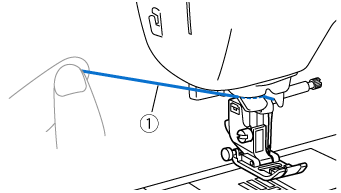
(1) 8 cm (approx. 3 inches) or more
-
Lower the presser foot lever to lower the presser foot.

-
Lower the needle threader lever on the left side of the machine as much as possible to make the hook turn.
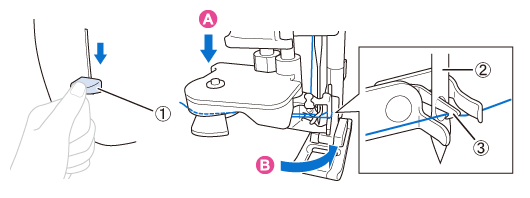
(1) Needle threader lever
(2) Needle
(3) Hook* After the threader thread guide disk is lowered (A), the hook turns (B).
If the needle is not raised to it's highest position, the needle threader cannot thread the needle. Turn handwheel counterclockwise until the needle is at its highest position. The needle is correctly raised when the mark on the handwheel is at the top, as shown under Preparing for threading step3.
-
Raise the needle threader lever slowly.
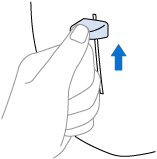
-
Carefully pull the end of thread that was passed through the eye of the needle.
If the needle was not completely threaded, but a loop in the thread was formed in the eye of the needle, carefully pull the loop through the eye of the needle to pull out the end of the thread.
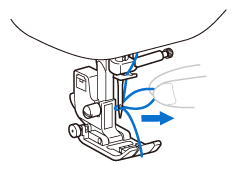
-
Raise the presser foot lever, pass the end of the thread through and under the presser foot, and then pull out about 5 cm (approx. 2 inches) of thread toward the rear of the machine.
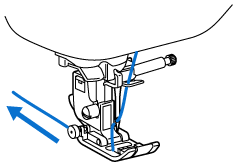
-
Press
 to unlock all keys and buttons.
to unlock all keys and buttons.
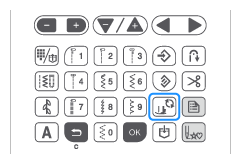
Threading the needle manually (without using the needle threader)
When using specialty thread, such as transparent nylon thread, a wing needle or a twin needle which cannot be used with the needle threader, thread the needle as described below.
-
Thread the machine to the needle bar thread guide.
For details, refer to “[1] Preparing for threading“ and “[2] Threading the upper thread“ .
-
Lower the presser foot lever.

-
Insert the thread through the eye of the needle from front to back.

-
Raise the presser foot lever, pass the end of the thread through and under the presser foot, and then pull out about 5 cm (approx. 2 inches) of thread toward the rear of the machine.

-
Press
 to unlock all keys and buttons.
to unlock all keys and buttons.
